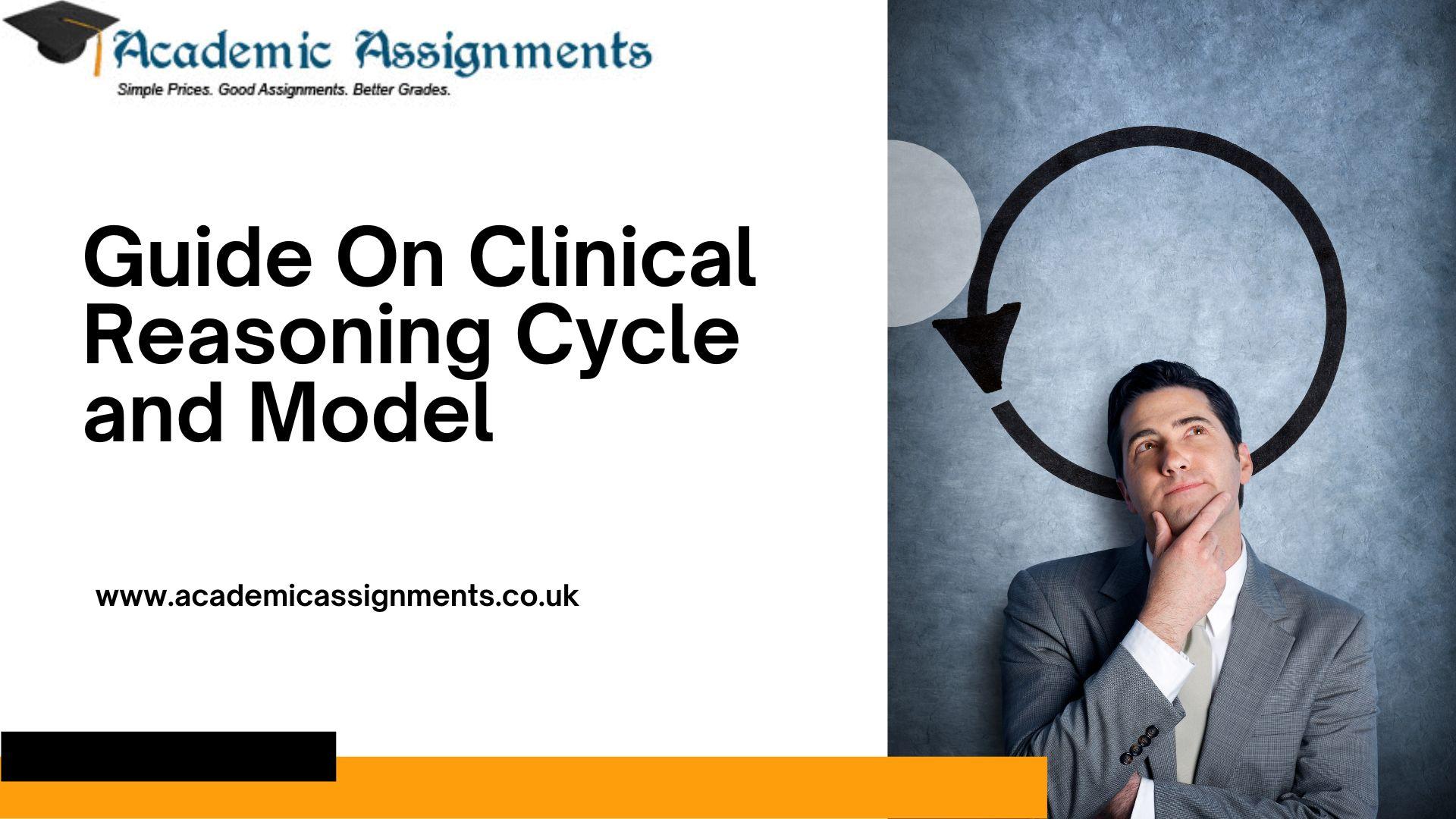Guide On Clinical Reasoning Cycle and Model
Clinical reasoning, clinical judgment, critical thinking, and decisive thinking are equivalent in medical and healthcare. They are frequently utilized interchangeably, which intuitively uncovers much about the clinical reasoning cycle. The equivalents related to clinical reasoning depict its criticality in healthcare and the dynamic medical cycle.
Nurses and healthcare providers utilize the clinical reasoning cycle and clinical reasoning skills for heap inspirations, each urgent to patient results. So we should investigate.
What Is Clinical Reasoning Exactly?
The clinical reasoning cycle is an essential reasoning and scientific interaction utilized by nurses and clinicians to:
- Gather signs and signals about the patient’s condition;
- Process obtained the information;
- Come to an understanding or result about a patient’s circumstance;
- Plan and execute cures and interventions;
- Assess impact and results;
- Ponder and gain from the cycle;
The viability of the whole clinical reasoning system is entirely founded on a ‘decisive thinking demeanour’. In this manner, decisive thinking and examination lie at the centre of each cycle stage. Likewise, an individual’s demeanour, way of dealing with difficulties, points of view, assumptions, and predispositions are influencing factors.
Why Is Clinical Reasoning Important?
Nurses and healthcare providers, by and large arrangement with pressing and basic patient situations. Opportune intervention and quick direction are vital in complex cases and for patients with different ailments and requirements.
- Studies uncover that nurses with commonsense clinical reasoning skills emphatically influence patient results. They can identify impending patient crumbling and administer appropriate cures under the wire.
- The essentialness of powerful clinical reasoning in nursing turns out to be significantly more prominent, notwithstanding increasing antagonistic patient results and escalating well-being concerns.
- Concentrates on exhibiting the ineffectiveness of customary and contemporary teaching methods and courses in cultivating sufficient clinical reasoning skills. In straightforward words, university courses don’t make their students work-prepared.
Anyway, how could nurses foster faultless clinical reasoning skills? How can one foster intense thoughts and carry out each phase of the cycle, practically speaking? Furthermore, what are the intricacies involved?
The following segment clarifies.
The Deep Dive Into Clinical Reasoning Cycle: 8 Phases and Their Significance
Understanding the clinical reasoning cycle becomes more straightforward with the help of the chart.
As may be obvious, the clinical reasoning model begins at 1200 and afterwards moves clockwise. The cyclic idea of the illustrations is illustrative of the ongoing and repetitive nature of clinical interventions and the vitality of assessment and reflection.
There are eight fundamental stages, stages or gradually works in the cycle. However, one imperative thing to note is that there are no obvious limits or distinctions between continuous stages. The clinical reasoning cycle can be separated into:
- Look and Consider
- Gather
- Process
- Choose
- Plan
- Act
- Assess and
- Reflect
There are no obvious limits between continuous stages in light of the ongoing idea of the clinical intervention and the powerful idea of healthcare. Subsequently, nurses frequently combine at least one phase and move back and forth between stages before arriving at a finding, taking intervening activity, and evaluating results.
Presently, we should investigate individual stages.
Stage 1: Look and Consider
The principal phase of the clinical reasoning cycle involves nurses gaining an initial impression of the patient and identifying what is going on’s most essential or recognizable highlights.
This is the alleged noticing time frame and is exceedingly urgent. However, tragically, it tends to be affected badly, and things can turn out badly by the guardian’s predispositions, assumptions and suspicions, inclinations and different mistakes, and inadequacies.
Stage 2: Collecting Cues/Information
The essentialness of this stage can never be overemphasized. Catching early, unpretentious prompts about the patient’s burdens and side effects can be basic in preventing unfriendly well-being results.
In this subsequent stage, the medical attendant assembles applicable information about the patient. Then, they audit the gathered information, including the patient’s medical reports, the handover report, clinical documentation, biomedical instrument records, and any remaining accessible information.
At this stage, nurses recognize and isolate significant information from unessential information. More significantly, they centre around unambiguous signals that can offer insights into the patient’s condition at that point.
Ultimately, nurses should review and relate the information to the patient’s circumstances. An expansive and profound understanding guides fruitful clinical reasoning radically.
Stage 3: Processing Information
The third phase of the clinical reasoning cycle will have the medical attendant interpret and dissect the gathered information.
They search for any huge abnormalities and deviations from fitting readings. Finally, nurses bunch and classify signs into meaningful gatherings, distinguish clinical examples, draw inferences, and foster a compelling theory.
Experienced nurses call upon their broad collection of information, skills, and past clinical experience to interpret the patient’s shoe. After cautious though, they then, at that point, choose a potential game-plan.
Stage 4: Identifying Problems/Issues
The fourth stage is where the parental figure integrates all gathered information and cycles them to determine the most fitting finding. The exactness in this stage is crucial as the nursing determination helps determine the difficulty and sensible consideration objectives.
A three-section ‘nursing’ finding or a two-section ‘risk’ conclusion are planned.
- A nursing finding becomes evident after topping to the bottom and interpreting both emotional and objective information. The three pieces of a nursing conclusion include the patient’s concern, associated aetiology (the causal connection among emergency and potential gamble variables, and all supporting proof/signals.
- Risk analyses are clinical decisions about a specific issue, wherein risk factors indicate further disturbance without legitimate nursing intervention.
Stage 5: Establishing Goals
The fifth cycle stage expects nurses to lay out clear objectives and focus on them accordingly. Objectives should be S.M.A.R.T. (Explicit, Measurable, Achievable, Realistic, and Timely). They should address recently distinguished nursing conclusions and help nurses determine the viability of their judgments and activities.
Stage 6: Act
Following up, nurses select the most suitable and conceivable strategy to accomplish their objectives. Activities should line up with the objectives and address the nursing analysis. At this stage, nurses likewise choose the ideal faculty for undertaking interventions and whom to inform, close by a commonsense timeline.
Stage 7: Evaluate Outcomes
Nurses rethink all gained objective, abstract information and patient prompts. They then, at that point, check out the adequacy of the interventions and find out whether there has been any improvement in understanding circumstances.
If there haven’t been any enhancements, nurses rethink what is happening and afterwards take part in the clinical reasoning cycle to think of a substantially more suitable strategy.
Stage 8: Reflections and Retrospections
Finally comes the stage when nurses think by and large.
This stage is pretty much as basic as different stages. This is because viable clinical reasoning skills require both sharp mental and metacognitive (thinking about how you are thinking) capacities. Furthermore, reflection and retrospection are fundamental for intensive learning and sharpening and refining skills, information, and thoughts.
Moreover, those were the intrinsic phases of the clinical reasoning model. Trust the above breakdown had the option to offer significant insights into the whole interaction.
If you are left with your clinical reasoning nursing assignments or need some dire nursing and medical assignment help, then, at that point, Academic Assignments has you covered!
Experience Exceptional Assignment Help From Experts At Academic Assignments
Academic Assignments is a leading scholarly specialist organization with many exceptionally qualified well-informed authorities. Profit of master direction for your nursing and medical assignment, theses, coursework, and more at appealing rates.
Here is a glance at our remarkable advantages and elements.
- Critical Academic Writing Help
- Online Academic Courses
- Direct Contact With Assignment Writers
- Join Bonuses
- Reference Discount and Seasonal Discounts
- Straightforward Payment and Refund Policies
- Severe Privacy
- FREE Academic Tools
- FREE Plagiarism Reports
- 24*7 Customer Support That’s Friendly and Helpful
Bring a finish to your scholarly battles and score more than ever with flawless nursing assignment help Academic Assignments!

 Blogs
Blogs





